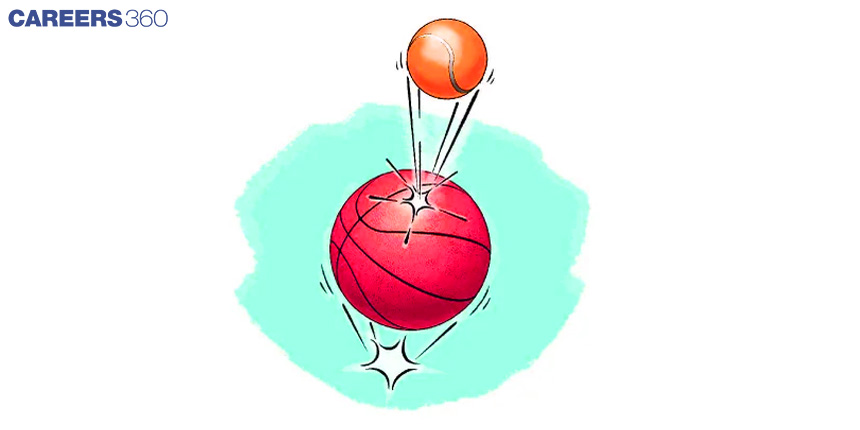Bouncing Balls - A Perfect Way To Understand Physics Of Elasticity and Energy Transfer
Have you ever noticed how balls bounce back when they hit the ground? It might seem simple, but there's a lot of interesting science behind it. We're going to explore two important concepts: elasticity, which is how things can squish and then go back to their original shape, and energy transfer, which is how balls use energy to bounce.
This Story also Contains
- Elasticity: The Foundation of Bounce
- Energy Transfer in Bouncing
- Physics Behind Bouncing
- Factors Affecting Bounce Height and Efficiency
- Exploring Bounce in Different Environments

Think about a rubber ball hitting the ground. It squashes a little and then pops back up. That's elasticity in action! It's like when you press a squishy toy and it goes back to its original shape. We'll learn more about how this works.
When a ball hits the ground and bounces, there's a cool thing happening with energy. The ball turns some of its energy into squishing and then turns it back into bouncing up. This energy game is not just fun to watch, it's also important in sports, making things, and even teaching science. So, let's dive into the fun world of bouncing balls and learn about elasticity and energy!
Elasticity: The Foundation of Bounce
Bouncing balls have a secret ingredient that makes them bounce – it's called "elasticity." Let's find out what this elasticity thing is all about and how it helps balls bounce back.
Elasticity is similar to a superpower that some materials possess. These materials can change shape when pressed or squashed, but only temporarily. They miraculously return to their normal shape after you stop squishing them. Consider extending a rubber band: when you pull it, it extends, but when you let go, it returns to its original size. Elasticity refers to a material's capacity to change shape temporarily and then bounce again.

"Hooke's Law" is an interesting concept that helps us understand how elasticity works. Assume you have a spring. When you push or pull the spring, it expands or compresses, but it returns to its original length if you don't push or pull it too hard. Hooke's Law states that the amount a material stretches or squashes is proportional to the amount of force applied. So, using a little force results in a small stretch; using a lot of force results in a large stretch. This law aids scientists and engineers in forecasting how materials would react when squeezed or stretched.
The elasticity of different materials varies. Some are extremely elastic, such as rubber, while others, such as hard rock, are not. What causes one material to be more pliable than another? A few factors come into play. The substance a material is formed of, known as its "composition," is important. Temperature also has an effect; some materials become more elastic when they are warm. It is also important to consider how the material was created and its structure. When it comes to bouncing balls, all of these factors can make the material more or less bouncy.
Energy Transfer in Bouncing
Up to this point, we've read the concept of elasticity, understanding how materials can squish and spring back into shape, giving bouncing balls their remarkable rebound. Now, let's shift our focus to another captivating aspect: energy transfer.
Consider energy to be a hidden power within things that causes them to do things. There are two types of energy in bouncing balls: kinetic energy and potential energy. Kinetic energy is the energy of motion; the ball possesses kinetic energy while it moves. Potential energy is stored energy that is ready to be utilised. The ball has potential energy when it is held high before being dropped. As the ball falls, its potential energy transforms into kinetic energy, causing it to move faster and faster until it collides with the ground.
Energy is a cunning traveller; it may transform from one form to another but cannot vanish. This is when the "conservation of energy" rule comes into play. As a ball bounces, its potential energy transforms into kinetic energy. But here's the fascinating part: the ball doesn't magically generate more energy when it bounces back up. Instead, as the ball slows down while rising, some of the kinetic energy from the fall is converted back into potential energy. This energy exchange is what allows the bounce to continue without violating any energy laws.
However, energy transfer is not always flawless. Damping and air resistance are two subtle causes that might reduce the bounce's vigour. Damping is analogous to an energy thief that steals a portion of the bouncing ball's energy, causing it to lose height with each bounce. Air resistance, on the other hand, acts as a restraining force against the ball's progress, sapping its energy and slowing it down. Because of these two causes, bouncing isn't always a never-ending spectacle of energy conservation.
Physics Behind Bouncing
Now that we've grasped the fundamentals of elasticity and energy transfer, it's time to delve deeper into the physics that governs the mesmerising bounce of balls.

A collision occurs when a ball strikes a surface and bounces back. However, not all collisions are created equal. Some are elastic, such as an extremely bouncy rubber ball you may have played with. The kinetic energy before the collision is equal to the kinetic energy after the impact in an elastic collision - energy is perfectly preserved. Inelastic collisions occur when some of the kinetic energy is lost during the collision. When a ball does not bounce as high as predicted, this can occur. Understanding these collisions helps us understand why certain balls bounce more enthusiastically than others.
When a ball bounces, its speed and direction change. The concepts of impulse and momentum drive this shift. Momentum is analogous to a moving ball's "oomph." Momentum is carried by something that moves. When a ball hits the ground and bounces, its momentum changes. The force that generates this change in momentum, on the other hand, is called impulse. Consider it the push that causes the ball to bounce. We can decode the science behind a ball's change in velocity and direction during a bounce by knowing how impulse and momentum interact.
Have you ever thought about how bouncy a ball is? The restitution coefficient is provided to assist us in measuring this. It's a technical word that describes how much energy is saved during a collision. The coefficient for an elastic collision is 1 - all energy is preserved. The coefficient for an inelastic collision is between 0 and 1, indicating how much energy was lost. Scientists and engineers can estimate how bouncy or squishy a collision will be by examining this coefficient.
Also check - Understanding Physics Concepts Through A Game Of Cricket
Factors Affecting Bounce Height and Efficiency
When it comes to bouncing, not all materials are made equal. Some are extremely bouncy, while others may appear lethargic. The key is in their material properties. Elasticity, which we've already discussed, is crucial. Different materials have varying degrees of elasticity, which means they can stretch and rebound to varying degrees. Because of their various elastic properties, a rubber ball and a plastic ball will react differently when they hit the ground. Understanding the variances in materials allows us to predict and explain why some balls bounce higher than others.
Consider dropping a ball from your waist versus dropping it from a building's height. The height from which the ball is dropped influences its bounce. The greater the drop, the more potential energy is gained by the ball, resulting in a more forceful collision with the ground. The additional impact force causes the bounce to be higher. We may vary the energy involved by changing the drop height and observing how it changes the height and vigour of the bounce.
The surface on which a ball bounces isn't just a passive backdrop; it has a considerable impact on the bounce's behaviour. Because less energy is lost to the surface upon impact, a smooth, firm surface may result in a larger bounce. A rough or soft surface, on the other hand, can absorb more energy, resulting in a less energetic bounce. As a result, a rubber ball may bounce higher on a wooden floor than on a carpet. Surface properties have a direct impact on how efficiently energy is transferred during a bounce, demonstrating the interdependence of materials and the environment.
Exploring Bounce in Different Environments
Let's step beyond Earth's bounds and understand how bounce behaviour shifts in distinct settings. From Earth's gravity to other celestial forces and the captivating realm of microgravity experiments, we'll unveil the diverse ways balls bounce in various environments.
Gravity acts as an invisible hand pulling objects towards the ground. A ball bounces according to the rules we have discovered on Earth, where gravity is relatively strong. But what if we extended our bouncing experience to other planets? A ball would bounce higher and more energetically on a planet with lower gravity than Earth. Similarly, on a planet with higher gravity, such as Jupiter, the bounce of a ball would be much shorter and less energetic. Understanding how gravity impacts bounce behaviour allows us to get insight into the different behaviours of bouncing balls throughout the universe.
Consider a universe in which everything appears weightless, where objects float and bounce with almost magical ease. This is the region of microgravity, which can be felt both in space and during freefall. The rules of bounce alter considerably in these contexts. A ball's bounce becomes a ballet of momentum and delicate forces with little interference from gravity. Microgravity experiments provide us with a once-in-a-lifetime opportunity to study the pure mechanics of bouncing without the main impact of gravity. These experiments not only increase our grasp of fundamental physics, but they also have practical applications. They assist us in developing materials that perform effectively in space, where classic concepts like elasticity and bounce can take on new dimensions.
Also check - Mathematics In Aviation: Analysing Flight Trajectories
Applications for Admissions are open.
As per latest syllabus. Physics formulas, equations, & laws of class 11 & 12th chapters
JEE Main Important Chemistry formulas
Get nowAs per latest syllabus. Chemistry formulas, equations, & laws of class 11 & 12th chapters
JEE Main high scoring chapters and topics
Get nowAs per latest 2024 syllabus. Study 40% syllabus and score upto 100% marks in JEE
JEE Main Important Mathematics Formulas
Get nowAs per latest syllabus. Maths formulas, equations, & theorems of class 11 & 12th chapters
